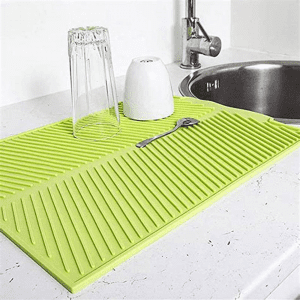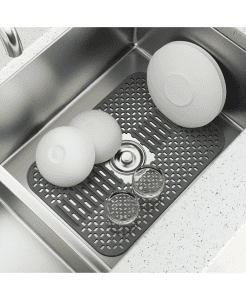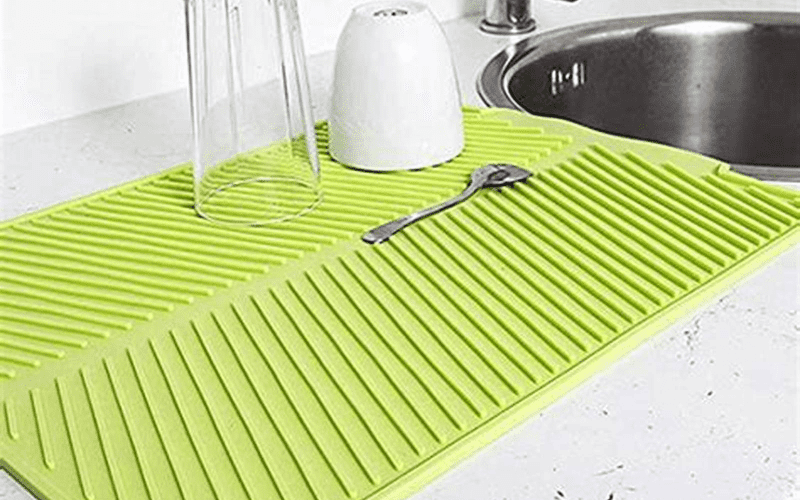Introduction:
Welcome to the world of dish drying mats, where the seemingly simple task of keeping them clean is an art form in itself. I’m Becky Rapin Chuk, to guide you through the intricacies of maintaining your dish drying mat. With years of experience and a passion for all things clean and organized, I’ve gathered expert insights to share with you, the lifestyle and home enthusiasts, who are ready to take your dish drying mat care to the next level. Your choice of dish drying mat can significantly impact your kitchen’s functionality and appearance. The most common materials include microfiber, silicone, and fabric. Each material has its unique characteristics, so it’s essential to understand what you’re working with.
Microfiber Mats
Microfiber mats are fantastic for quick drying but can trap odors. To keep them fresh, machine wash in cold water with mild detergent, and air dry. For stubborn stains or odors, add a cup of vinegar during the rinse cycle.

Silicone Mats
Silicone mats are heat-resistant and perfect for protecting countertops. To clean, simply place them in the dishwasher or hand wash with mild detergent. Wipe them dry with a clean cloth.
Fabric Mats
Fabric mats are great for adding style to your kitchen. Machine wash with like colors, using a mild detergent, and air dry to maintain their appearance.
Cleaning Mistakes
Using Harsh Chemicals: Avoid harsh chemicals as they can damage the materials and leave toxic residues. Stick to gentle dish soap or natural cleaners.
Neglecting Drying: Ensure your mat is thoroughly dried after each use to prevent mold growth. Hanging it up or laying it flat can make a big difference.
Scratching Silicone: Be gentle when cleaning silicone mats to prevent scratching. Opt for soft sponges or cloths.
Cleaning Techniques:
Mold Prevention: To prevent mold growth, ensure your mat is completely dry before storing it. If you live in a humid climate, consider using a dehumidifier in your kitchen.
Rotate Mats: If you have multiple mats, rotate their use to prevent excessive wear and tear on a single mat.
Inspect Regularly: Check your mat regularly for any signs of wear, tear, or damage. Replace it if needed to maintain hygiene and functionality.
Use a Mat Liner: Place a liner or tray under your mat to catch any excess water, preventing damage to your countertop.
Scented Sachets: Keep your mat smelling fresh by placing scented sachets nearby or inside your kitchen cabinets.
Rotate Air-Drying Locations: Change the location where you air-dry your mats to prevent moisture buildup in one area.

KeyPoint
| Material | Benefits | Maintenance |
|---|---|---|
| Microfiber | Quick drying, easy to clean | Machine wash, air dry. |
| Silicone | Heat resistant, non-slip | Dishwasher safe, wipe dry. |
| Fabric | Stylish, soft, but absorbs moisture | Machine wash, air dry. |
Conclusion:
We’ve explored the three primary materials that dish drying mats are made of: microfiber, silicone, and fabric. Each has its unique characteristics, catering to different needs and preferences. Whether you favor the quick-drying efficiency of microfiber, the heat-resistant and non-slip properties of silicone, or the style and absorbency of fabric, we’ve equipped you with the knowledge needed to make an informed choice. Moreover, we’ve addressed the common cleaning mistakes that many of us inadvertently make. By avoiding harsh chemicals, ensuring thorough drying, and being gentle with silicone mats, you can prolong the lifespan of your dish drying mat and maintain its functionality. The advanced cleaning techniques provided for each material ensure that your mat remains not only clean but also odor-free. From machine washing microfiber to dishwasher-safe silicone mats, these techniques will make the cleaning process a breeze.












